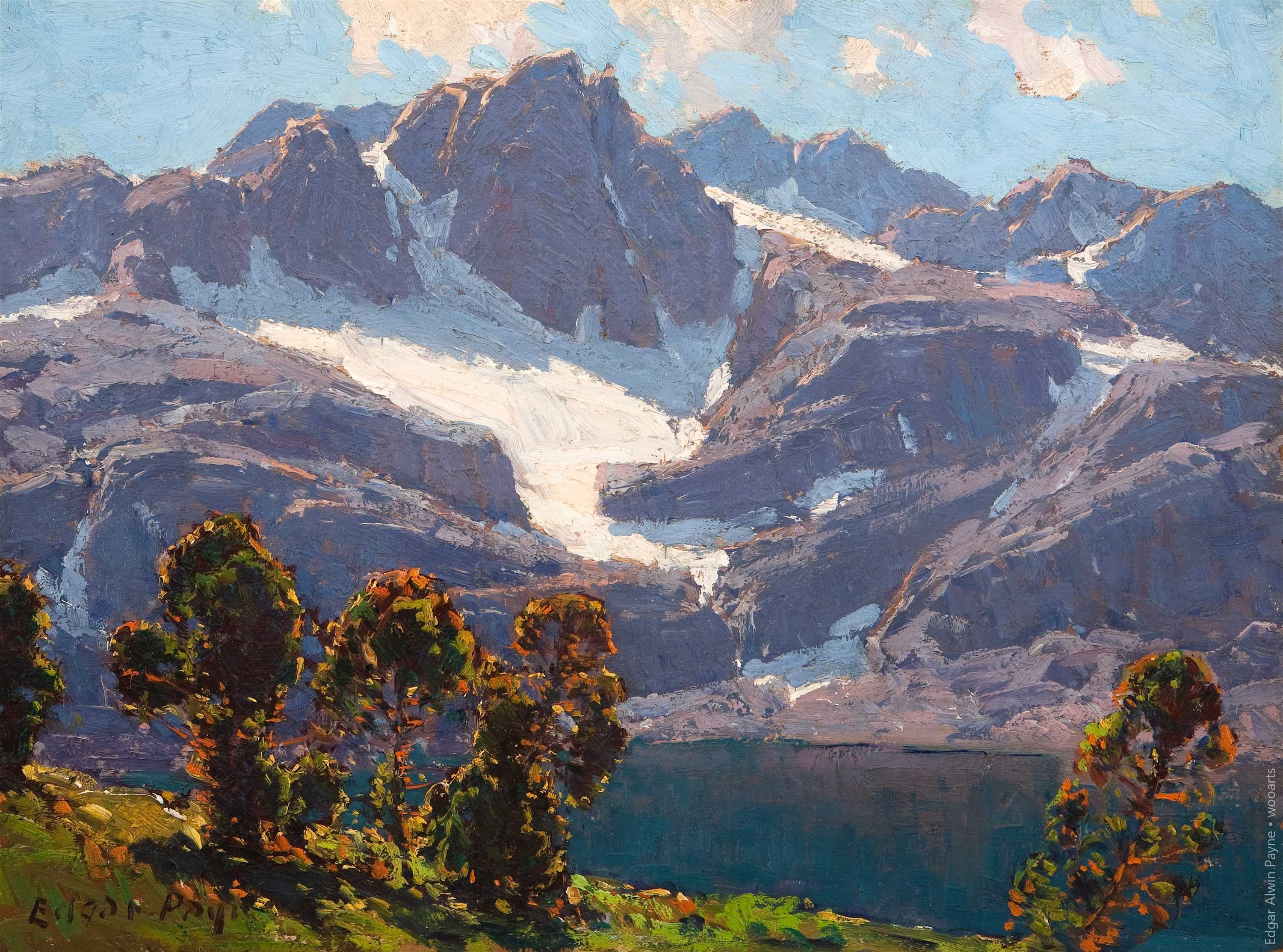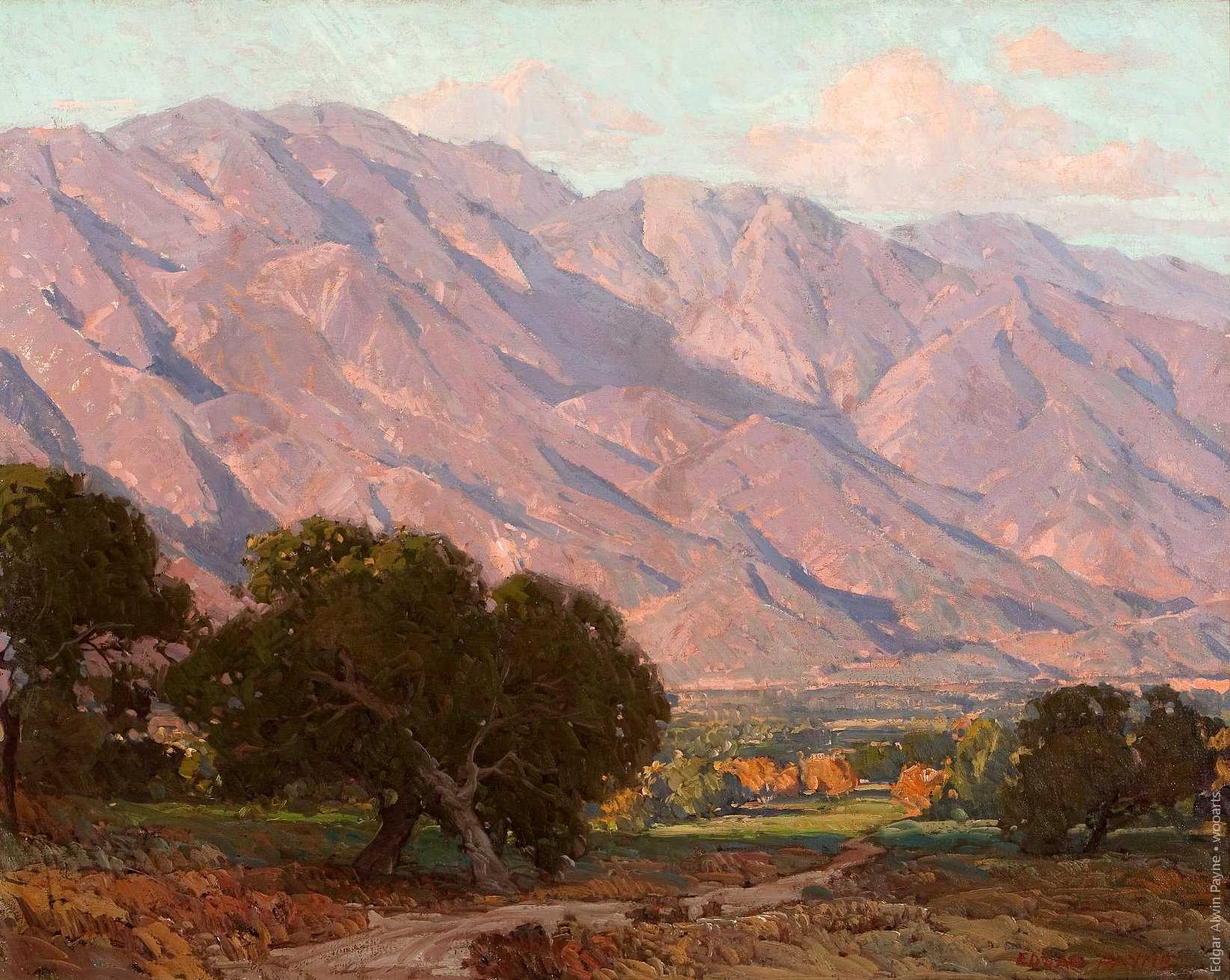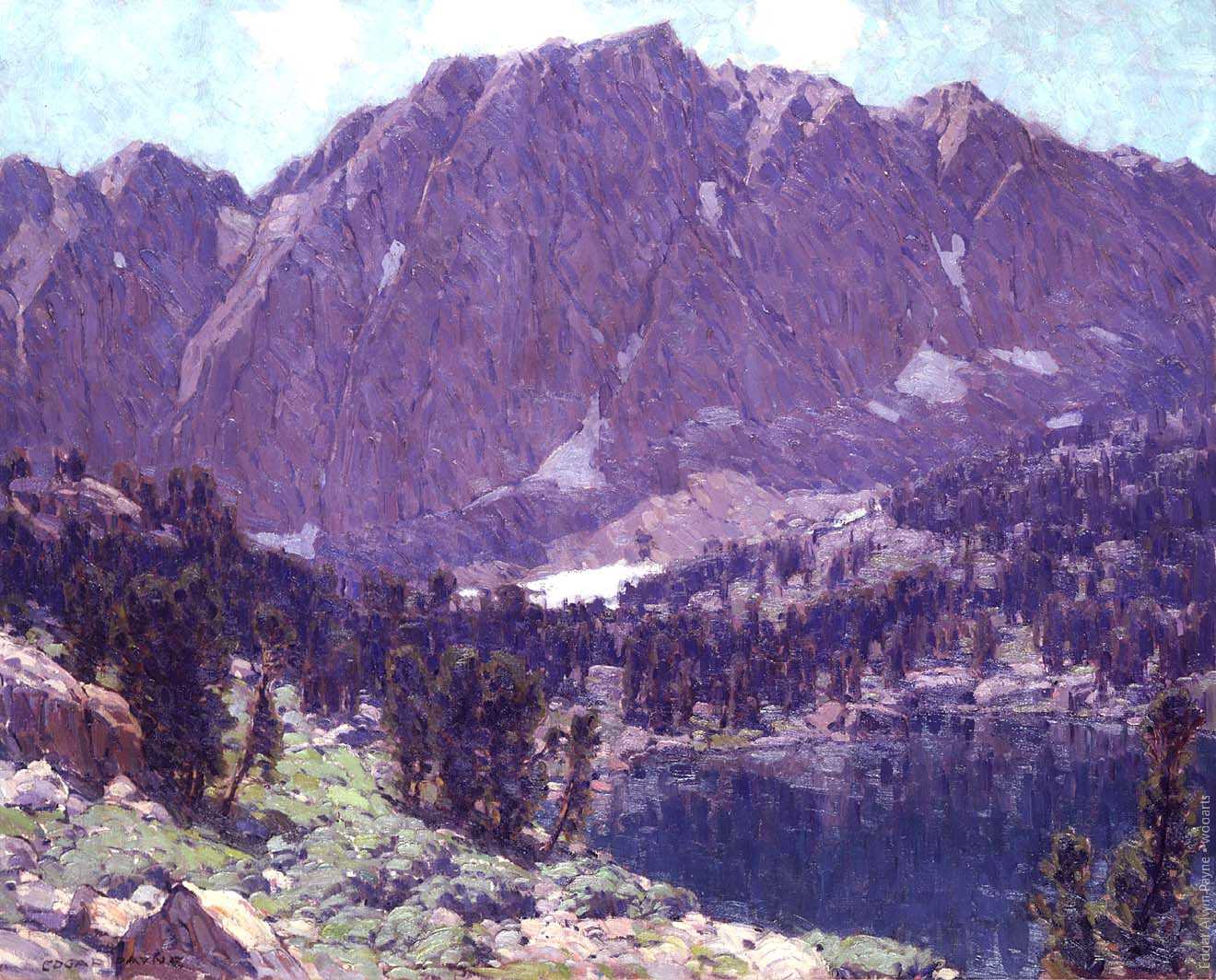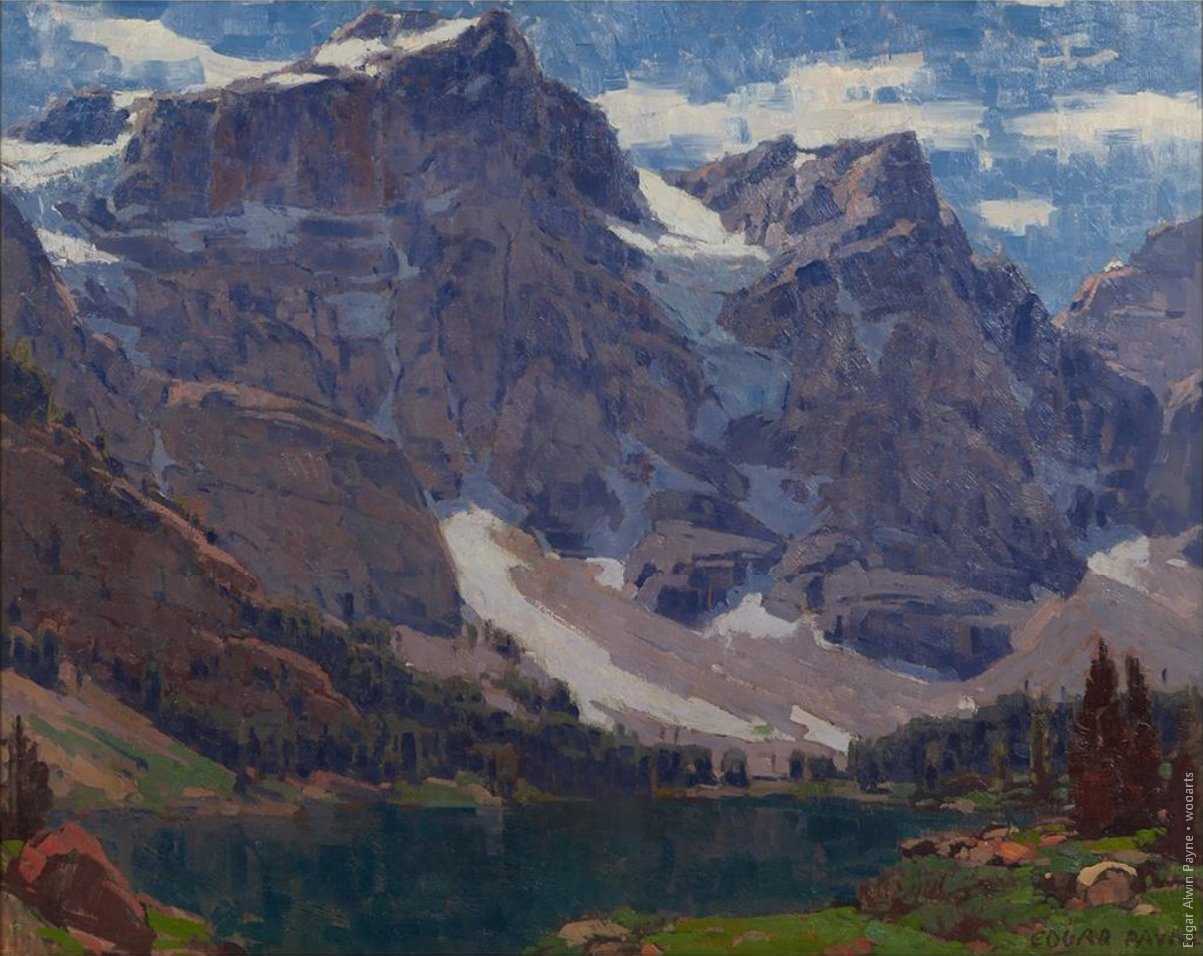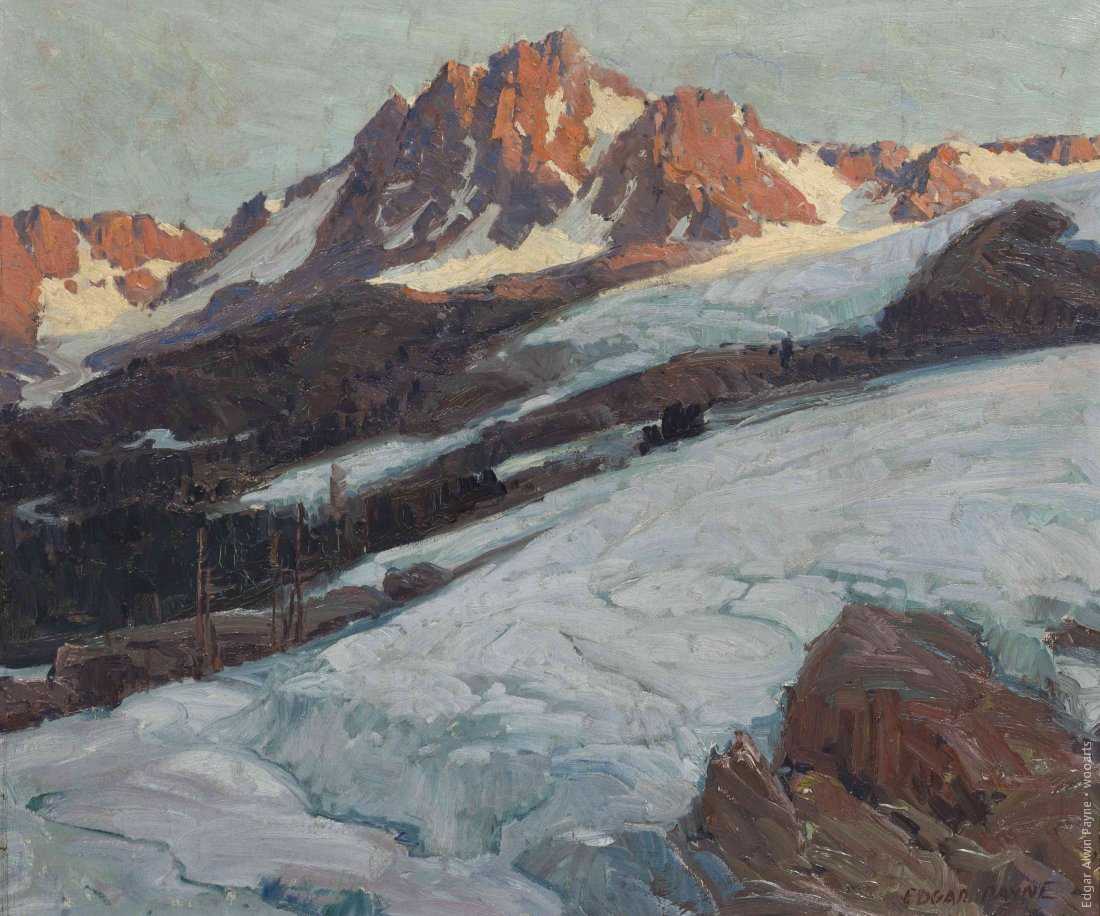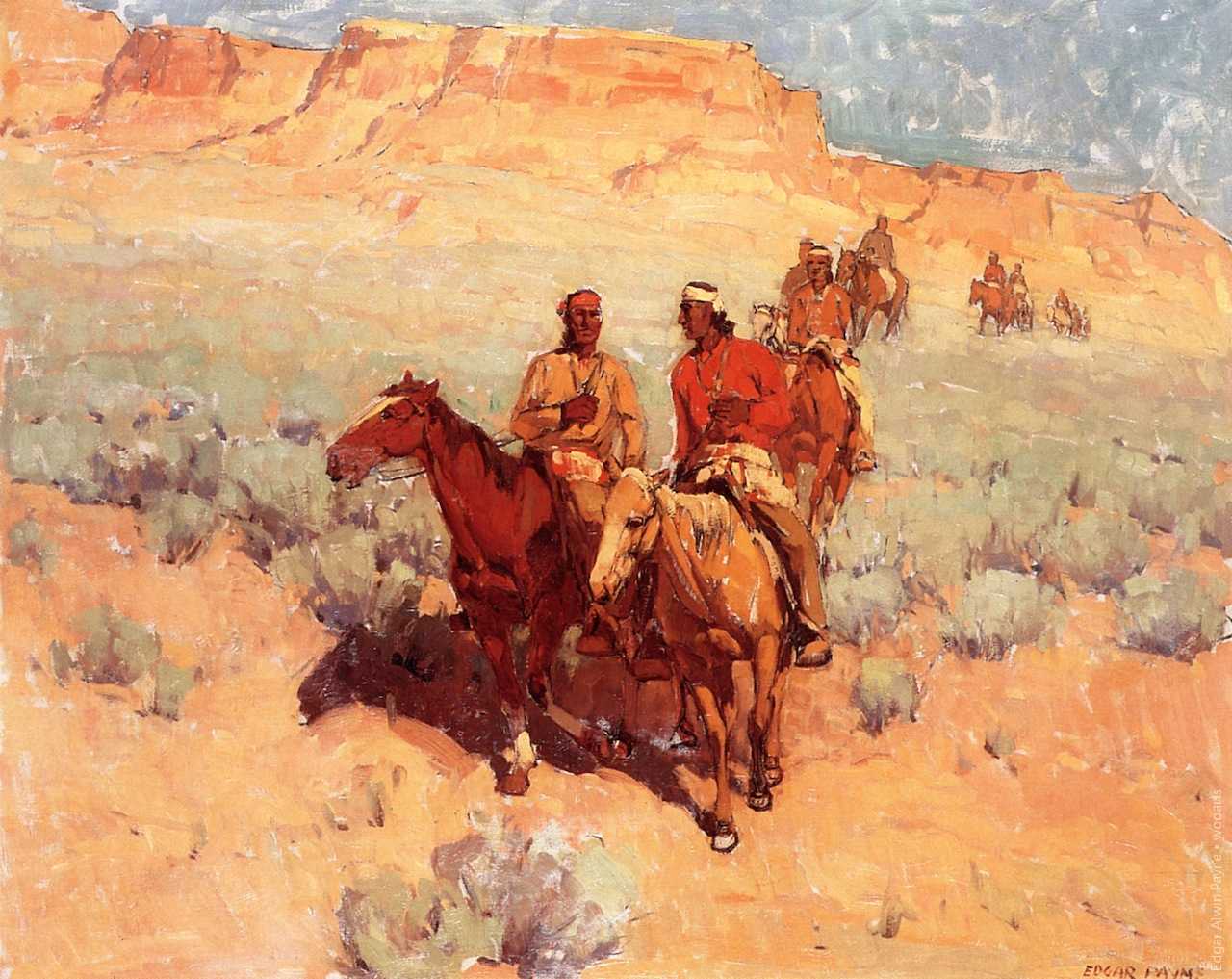Lured by the quality of light and freedom to paint open spaces and possessing a reverence for nature, he especially loved the mountains and frequently took packhorses into the Sierra Nevada Mountain Range to paint and sketch the upper lakes. Recognized as one of California’s leading landscape artists, Payne earned the respect of his peers and critics for his Impressionistic landscapes painted in plein-air. His works are in the permanent collections of the Laguna Art Museum, Chicago Art Museum, Southwest Museum of Los Angeles, Pasadena Art Institute, and the National Academy of Design.
At the age of fourteen, Edgar Payne left his childhood home of Washburn, Missouri, to travel the United States and Mexico. Payne survived by performing odd jobs including painting signs, stage sets, and houses. Payne, who had a fifth grade education, considered himself to be primarily self-taught.
However, he received art training at the Payne-Morris Studio in Dallas, Texas, and at the Art Institute of Chicago, eventually becoming one of the primary plein-air landscape painters in the early 20th century. Beginning in 1910, Payne found employment painting murals in civic buildings, courthouses, and theatres throughout the Midwest.
He married fellow artist, Elsie Palmer, in 1912, and in 1915 Payne moved with his family to Santa Barbara, California where he began to focus more of his time on easel painting. Payne relocated to Laguna Beach, California, in 1919 where he became the founding president of the Laguna Beach Art Association, which is presently known as the Laguna Beach Art Museum.
Edgar Alwin Payne (1 March 1883 – 8 April 1947) was an American Western landscape painter and muralist.
Early life
Payne was born near Cassville, Barry County, Missouri, in the heart of the Ozarks. Cassville is in southwest Missouri, near the Arkansas border. Despite his relative isolation this turn-of-the-century Missouri teenager toured the world. Before Edgar was done he would crisscross the United States, travel to Mexico, Canada, and Europe, and even spend the summer in the Alps. But, like John Muir before him, and Ansel Adams after, it was the American West that most appealed to his heart.
According to the U.S. Census of 1900, he resided with his parents, two sisters and five brothers in Prairie Grove, Washington County, Arkansas; his Alabama-born father was employed as a carpenter. Edgar’s occupation was listed as “carpenter, apprentice.” Leaving home on several occasions, Payne painted houses, signs, portraits, murals, and local theater stage sets, to pay his way. Traveling through the Ozarks, then around the Southeast and Midwest, he finally wound up in Chicago, and enrolled to study portrait art at the Art Institute of Chicago. He remained only two weeks at the institute, finding it too structured. He preferred instead to be self-taught, relying on practice and his own sense of direction.
Struggling at first, he soon exhibited a group of landscape works, painted on a small easel, at the Palette and Chisel Club. During this period he also obtained the occasional mural work to supplement his income.
He made his way to California for the first time in 1909, at the age of 26. He spent several months painting at Laguna Beach, then headed to San Francisco. In San Francisco he met other artists, including commercial artist Elsie Palmer (1884–1971). He returned to California for a second time in 1911. When he returned to Illinois that fall, he found that Elsie had taken a job as commercial artist in Chicago. This cemented their already growing interest in each other. On the morning of their wedding day about a year later, 9 November 1912, Edgar noticed that the light was “perfect”, and had Elsie postpone the ceremony until the afternoon. Luckily the artist in her offered some understanding.
As a couple they became well known in Chicago’s art circle. Elsie helped Edgar with his mural work, and soon he had an exhibition at the Art Institute of Chicago. Arguably their greatest collaborative effort happened in 1914 with the arrival of their daughter, Evelyn. Between 1915 and 1918-19 Edgar maintained a professional address in Chicago at the Tree Studio Building on East Ohio Street.
Major breakthroughs
The following spring they took Evelyn to see her maternal grandparents in San Francisco. They also attended the Panama-Pacific International Exposition. The following year Edgar made his first trip to the Sierra Nevada Mountains. This trip was a big moment in his life, and Payne would return again and again to paint the unspoiled Sierra; these paintings remain one of the hallmarks of his work.
He earned his first major commission in 1917. In a bid to attract tourism, the Atchison, Topeka and Santa Fe Railroad asked him to paint the Southwest, along the railroads’ trek from Albuquerque to California. This commission not only solidified his reputation as an artist, it also forever linked him to Western America. Although he painted in Europe, he is most remembered for his work from the Four Corners area of the Navajo Nation Reservation, Yosemite, and the California coast. That year he and Elsie spent four months painting, exploring, and taking in Canyon de Chelly. This area, from Taos, New Mexico to the Grand Canyon, became one of Payne’s two main inspirations for the next twenty years.
The Santa Fe Railroad commissions were the turn of the century brainchild of William H. Simpson, chief of the railway’s advertising department. Starting in 1892, with Thomas Moran, Simpson exchanged travel on the train, along with lodging at railroad hotels and meals at railroad restaurants, and sometimes even cash, for paintings, photographs, pottery, and jewelry. This endeavor lasted for decades and made the Santa Fe one of the largest collectors of southwestern fine art.
When the Santa Fe commission expired the couple returned to San Francisco. Edgar received a commission from the Congress Hotel in Chicago for a mural on 11,000 square yards of muslin. The mural was to cover several floors of the hallways of the hotel. Payne rented a warehouse in Glendale, California and hired other artists, including Elsie, to help complete the work.
In 1918, Edgar and Elsie made their home and studio in Laguna Beach. He helped to organize the Laguna Beach Art Association, and become its first president. They spent the next four years painting their way through the southwest, in places like Canadian Rockies in British Columbia and Alberta, Canada, and then exhibiting in the Los Angeles area. Sometimes their trips would involve hiking into the backcountry, looking for undisturbed places of raw and rare beauty to paint, sometimes for weeks. Edgar exhibited extensively in California, including such important venues as the California Art Club (1918-1921), California State Fair (gold medal 1918; silver medal in 1919), Cannell & Chaffin Galleries (1920), and Stendahl Galleries (1921-1922). The Paynes spent part of the summer of 1921 at the California art colony of Carmel-by-the-Sea where Edgar exhibited his work at the Fifteenth Annual Exhibition of the local Arts and Crafts Club. After finding success during this period, the trio took a two-year “painting tour” of Europe, 1922-1924. Painting in Brittany, Paris, Provence, Switzerland, and Venice. His favorite place in Europe was the Alps, where he painted the Great White Peak of Mont Blanc, which the Paris Salon gave “an honorable mention” in spring 1923.
“The Great White Peak” is reputed to be in the collection of Newport Harbor High School in Newport Beach, California. This painting, and others, formed a collection of annual acquisitions at an art show sponsored to acquaint high school students with styles of painting and art. The collection was forgotten and distributed to various offices (and closets) in the school district. Its existence was rediscovered by school librarian John McGinnis who tracked down and restored all 56 of the missing paintings. The collection is now known as “The Ruth Stoever Fleming Collection”.
Upon returning the U.S. in the fall of 1924, the Paynes first stayed in Chicago, then went back to Laguna Beach, and then to New York City in 1926. Always on the go, they painted in Arizona, California, the California Sierras, Connecticut, New Mexico, New York, and Utah. They spent summers crossing the country, painting as they went. They returned to Europe to paint the harbors of Brittany, and Chioggia, in 1928. The following summer they painted Lake Louise, Alberta.
Later life
After the financial collapse of 1929, and the subsequent Great Depression, commissions didn’t come as easily, so the Paynes returned to Southern California on a more permanent basis, purchasing a new Los Angeles, studio-home, in 1932. During this time, Evelyn would marry, and Edgar and Elsie would become separated that same year. Edgar moved to Hollywood, to a small studio-home on Seward Street. However, he would spend a great deal of his time in the California Sierra Nevada Mountains, painting his favorite subject.
His lifelong obsession with the Sierras would lead him to produce a documentary film, “Sierra Journey”. In 1941 he wrote “Composition of Outdoor Painting”, a comprehensive book on composition and composition forms. The book also explains landscape painting techniques, color, repetition, rhythm, and value. The seventh edition printing of the work was completed in 2005.
After a 14-year separation, Elsie returned to help Edgar in 1946, upon learning that he had cancer. She stayed with him until he died, 8 April 1947.
There is a bronze relief sculpture of Edgar at the Laguna Beach Art Museum, done by Elsie in 1952. She championed his work until her own health, and degradation of eyesight, caused her to stop in 1959. She moved in with Evelyn and her husband, in 1969, in Minneapolis. Elsie died peacefully 17 June 1971.
You can find works of Payne’s that are of Italian harbors, the Alps, landscapes of Laguna, but Edgar Alwin Payne is most remembered for his work of American Indians of the Four Corners area, and, of course, the paintings of his beloved Sierras. In the Sierras, high up in Humphrey’s Basin, you will find the lake named for him, Payne Lake.
His work was an influence on Bill Wray, John Deckert and other painters.
Galleries and collections with Payne’s works
- Steven Stern Fine Arts: Beverly Hills, California
- Utah Museum of Fine Arts at the University of Utah
- Chicago Art Museum
- University of Nebraska Galleries
- Fleischer Museum (Scottsdale, Arizona)
- Indianapolis Museum of Art
- Laguna Art Museum, California
- Edgar Payne Gallery, California
- National Academy of Design Collection
- National Collection of Fine Arts, Senate Building (Washington D.C.)
- Pasadena Art Institute
- Pasadena Museum of California Art
- Southwest Museum of Los Angeles
- Springville Museum of Art (Springville, Utah)
- [The Redfern Gallery, Laguna Beach, California
- Edgar Payne Artwork, Laguna Beach, California
- The Crocker Art Museum, Sacramento, California
- The Weisman Art Museum, University of Minnesota, Minneapolis, Minnesota
- William A. Karges Fine Art
Memberships
- Allied Art Association
- American Artists Professional League
- California Art Club (President, 1926)
- Carmel Art Association
- Chicago Society of Artists
- International Society Art League
- Laguna Beach Art Association
- Palette and Chisel Club
- Salmagundi Club (NYC)
- Ten Painters of Los Angeles
Born in Washburn, Missouri, Edgar Payne became one of the foremost plein-air landscape painters of California in the early 20th century. He is best known for his majestic Sierra Nevada Mountain scenes, and depicted so many Indians on horseback riding through the Sierra Nevada Mountains that a mountain lake, Lake Payne, was named for him. He painted many works “en plein air” and also did numerous sketches from which he later did studio paintings.
He worked quickly and completed about one painting per day. He depicted many other locations as well including the coast of Laguna Beach, the Canadian Rockies, the French and Swiss Alps, the Italian and French Riviera, fishing scenes of Italy and France, and landscapes in the Southwest including the Grand Canyon and Canyon de Chelly in Arizona.
Payne was active in Chicago early in his career and there had a distinguished reputation for painting stage scenery for famous actresses and for mural painting.
He left home at age 14 because his father objected so strongly to his son’s dedication to an art career. He earned money painting houses, stage sets and murals, and traveled through the Ozarks, Texas, Mexico and Chicago where he received a major commission from the Congress Hotel for an 11,000 foot mural of Italian gardens. (Since destroyed). In Chicago, he was active with the Chicago Society of Artists and the Alumni Association of the Art Institute.
He was self-taught except for a brief period at the Art Institute of Chicago. Of his art education, his daughter said: “My father never studied with anyone. He tried the Chicago Art Institute for a little while, but he didn’t like it. He considered himself to be completely self-taught.” (“Plein Air” 26)
In 1909, he first visited California and painted scenes of Laguna Beach and San Francisco. During this time he discovered the beauty of the Sierra Nevada mountains, where he returned continually throughout his career for the inspiration that led to his signature paintings and a turning from murals and stage sets to landscape painting.
He married artist Elsie Palmer in 1912, and the couple with their daughter, Evelyn, born in 1914, moved to Laguna Beach. They rented a beach-side cottage while Edgar built a home, which was the only one the family ever owned. They lived in it for three years, and it was a uniquely stable time for the family that traveled frequently in search of painting subjects.
Payne decided he wanted to have an art gallery for exhibiting artists, and in 1920 he became the founder and first president of the Laguna Beach Art Association and the Gallery of Laguna Beach. The first meeting was held in his studio. The Paynes later moved to Los Angeles so they could be closer to the Stendahl Galleries, which was in the Ambassador Hotel and represented his work.
In 1916, the Santa Fe Railroad commissioned him to paint the Southwest, and the couple spent four months in Canyon de Chelly. They also traveled and sketched the Grand Canyon and scenes of New Mexico and spent several years, 1922 to 1924, in Europe. Payne had a commercial artist friend, George Evans, who visited them in Europe, and according to Payne’s daughter, Evans and the Paynes spent much time looking at artwork in museum. In the 1923 Paris Salon, Payne won an Honorable Mention, which was significant recognition because more than 7000 paintings were exhibited.
During the Depression, Payne took teaching jobs to earn money for him and his family, and he also wrote his book, “Composition of Outdoor Painting”, which, with many printings, has been a popular guide to landscape painting. He and his wife continued to spend much time in New York City and had planned to build a house there, but did not start the project because of the economy.
The couple separated in 1932, but Elsie, who subsequently had a very successful career, returned to live with him towards the end of his life when he was ill. A major problem between them was his dominant personality and her resentment that her own considerable talents were submerged by his demands. Apparently he felt remorse. Their daughter wrote that “the last words her father spoke to her on his last day of life in 1947 were that ‘he was sorry he had been so selfish and that everything had been for his art.’ ” (“Plein Air” 26)
Associations:
Salmagundi Club
Allied Art Association
International Society Art League
California Art Club (President 1926)
Laguna Beach Art Association
Ten Painters of Los Angeles
Palette & Chisel Club, 1913
Chicago Society of Artists
American Artists Professional League
Carmel Art Association
Exhibitions:
California State Fairs, 1917 (prize),1918 (prize)
Sacramento State Fair, 1918 (gold)
Sacramento, 1919 (medal)
Los Angeles County Museum of Art, 1919 (solo), 1926 (gold medal)
Art Institute of Chicago, 1920 (prize)
Southwest Museum, 1921 (prize)
Pennsylvania Academy of Fine Arts Annual,1921,22,25
Paris Salon, 1923
National Academy of Design, 1929 (prize)
Golden Gate International Exposition, 1939
California Art Club, 1947 (prize).
Public Collections: Murals
Empress Theatre & American Theatre, Chicago
Clay County Court House, Brazil, IN
Hendricks County Court House, Danville, IN
Queen Theatre, Houston
Public Collections: Paintings
Nebraska Art Association, Lincoln
Peoria Society of Allied Artists
Herron Art Institute
Municipal Art Commission
Janesville (WI) Art Association
Indianapolis Museum
Laguna Art Museum
Bancroft Library, UC Berkeley
National Academy of Design
National Museum of American Art, Washington D.C.
Pasadena Art Institute
Pasadena Art Museum
Southwest Museum of Los Angeles
Springville (UT) Museum of Art
University of Nebraska Galleries
Art Institute of Chicago
Oakland Museum; Irvine Museum, CA
Fleischer Museum, Scottsdale, AZ
Sources:
Evelyn Payne Hatcher, Plein Air Magazine, June 2004
Donald Hagerty, Leading the West
Edan Hughes, Artists in California, 1786-1940
Redfern Gallery, Laguna Beach
The Sierra Nevada Mountains were to the California plein-air painter Edgar Alwin Payne what Mont Sainte-Victoire was to the French Post-Impressionist Paul Cézanne: an evergreen source of subject matter and technical experimentation. Indeed, by the end of his career, Payne had become so associated with the Sierra Nevada, for years completing approximately one mountain painting per day and even producing a movie called “Sierra Journey,” that “Payne Lake” at Humphrey’s Basin was named after him.
Payne left his hometown of Washburn, Missouri, at age fourteen and cut his teeth on the artist’s trade by painting signs, murals and set designs in the Ozarks, Texas, and ultimately Chicago, where he trained for a brief two weeks at the Chicago Art Institute. A trip to the West Coast in 1909 exposed Payne for the first time to the majesty of the California landscape, from the hills of San Francisco to the high peaks of the Sierras to the shores of Laguna Beach, which soon became his home base.
During the teens, Payne traveled and painted throughout the Southwest, under the auspices of the Santa Fe Railroad, and during the 1920s he and his wife, Elsie, lived in New York, but it was always California that fueled his artistic energy. In 1919 Payne founded the Laguna Beach Art Association and the Gallery of Laguna Beach, and by the early 1930s he had returned to Los Angeles, thereafter continuing his frequent trips to the Sierras. Payne’s 1941 treatise, “The Composition of Outdoor Painting,” underscored the ideal effects achievable through serial painting: “A painter needs to study, meditate and experiment and practice interminably in order to produce a painting that would have nobility in its concept, variety, rhythm, repetition, unity, balance and harmony in its composition.”
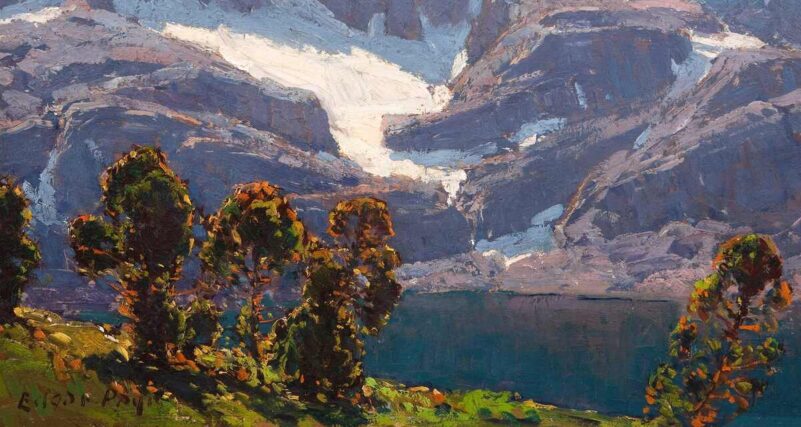
View Edgar Alwin Payne Paintings
